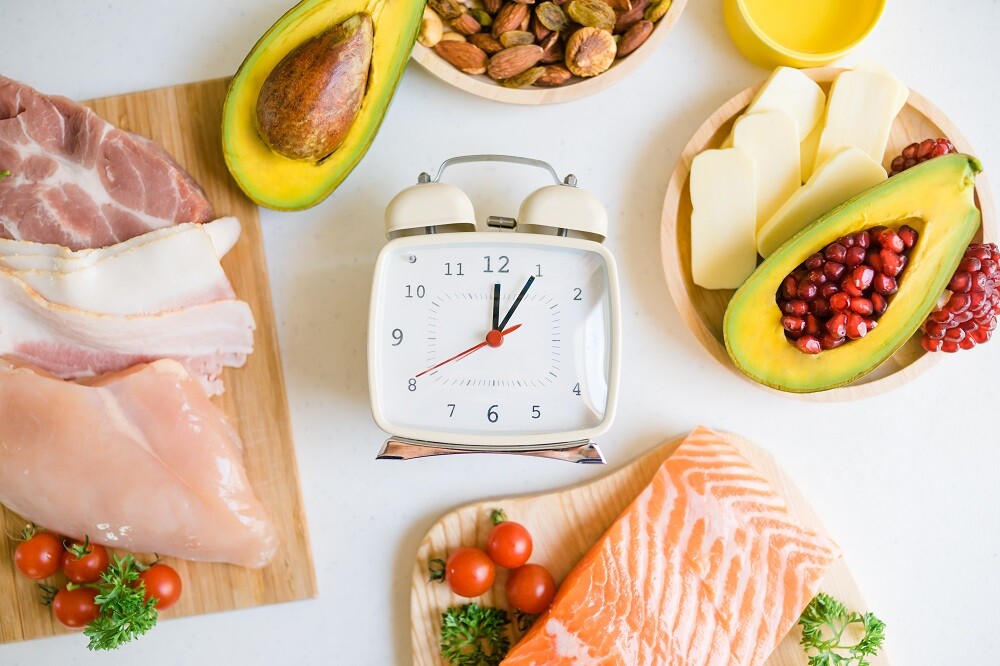Intermittent fasting has gained popularity over recent years, with large thanks to Dr Michael Mosley and his 5:2 Diet. Intermittent fasting essentiall...
Intermittent fasting has gained popularity over recent years, with large thanks to Dr Michael Mosley and his 5:2 Diet. Intermittent fasting essentially refers to periods of voluntary abstinence from food.
There are many benefits of fasting, with the most popular benefit being weight loss. Other benefits include improvement in cholesterol levels, improvement in blood glucose levels and insulin, as well as a decrease in inflammation and improvements in asthma, seasonal allergies, rheumatoid arthritis, osteoarthritis, cardiac arrhythmias and menopausal hot flushes! There are some reports that suggest intermittent fasting can even improve sleep, resistance to infection and the gut microbiome!
There are several different ways to do intermittent fasting, whether it be alternate day fasts, modified fasting (for example the 5:2 diet) or time restricted feeding. There are also fasts for religious reasons, for example Ramadan.
Alternate days fasts are just that – for one day, you restrict any energy-dense, or high calorie foods and on the next day you eat as normal, then restrict energy-dense food again the next day, and so on.
Modified fasting means that you eat 20-25% of your usual calorie intake on fasting days. The most widely known example of modified fasting is the 5:2 diet (or the Fast Diet), made popular by Dr Mosley. In this 5:2 diet, calories are restricted to 500-600 calories for any two days of the week, and for the remaining five days, food is eaten as per normal. This way of eating seems to be easier to follow than continuous calorie restriction.
An example of a 500-calorie day is:
Breakfast (197 calories)
Porridge made with 40g oats and water. Top with 75g blueberries.
Dinner (306 calories)
Chicken stir-fry: cut a 140g chicken fillet into strips. Fry in a non-stick pan with 1 teaspoon olive oil, along with 1 teaspoon finely chopped ginger, 1 tablespoon chopped coriander, 1 clove garlic (crushed), 2 teaspoons soy sauce and juice of half a lemon until browned and sealed, add water if chicken sticks to the pan. Add a handful (50g) of snow peas, 100g finely shredded cabbage and 2 (160g) carrots cut into thin strips and cook for 5-10 minutes until the chicken is cooked, adding water if necessary.
Snack (26 calories) 10 medium sized (120g) strawberries
You can find more recipes like these, and more information about the 5:2 diet from Dr Mosley’s book “The Fast Diet”, available from his website, www.michaelmosley.co.uk or on the fast diet website, www.thefastdiet.co.uk.
Modified fasting can also be done on a 6:1 pattern, where fasting occurs on just one day per week or 4:3 pattern, where fasting occurs 3 days per week. It is important to make sure that eating is not out of control, or of poor quality on non-fasting days. If you eat huge amounts, or unhealthy food on normal eating days, health benefits are unlikely to occur.
Time restricted feeding occurs when food is eaten within certain hours of the day. The idea behind this is that during the hours that are spent eating, the body is storing fat, and during the hours that are spent fasting, the body is burning fat. Thus, the more time spent fasting, the more fat burning occurs.
The most common time restricted feeding is known as “16:8”, where 16 hours of every 24-hour day is spent fasting, leaving an 8-hour window for eating. Another type of time restricted feeding is the Warrior Diet (or the 20-hour fast). In the Warrior Diet, the eating window is reduced to 4 hours per day. There is also an emphasis on unprocessed and natural foods. Find out more about time restricted fasting at www.dietdoctor.com/short-fasting-regimens.
Dr Mosley is currently promoting a new type of time restricted feeding. This is specific for those who want to lose weight and reduce blood sugar levels. This Fast 800 diet involves 3 phases – eating 800 calories per day for a minimum of 2 weeks, with a period of 12 hours fasting overnight. Phase 2 involves the 5:2 style of fasting, eating a Mediterranean diet on the normal eating days, with a period of 14 hours of fasting overnight. Phase 3 is the maintenance phase, where if the weight is starting to creep back up, you choose between intermittent fasting, the Fast 800 diet, the 5:2 diet or a combination of intermittent fasting and 5:2 diet.
The imperative part of any fasting diet is that the person should eat good quality, nutrient-dense foods during their periods of non-fasting, which Dr Mosley has recognised by introducing the Mediterranean Diet into his latest method. Whichever fasting method you choose, you should remember that the quality of the calories you are eating is important. You won’t reap any benefits if you eat junk food such as chocolate, chips, biscuits and ice cream during your eating windows.
It is also important to discuss fasting with your healthcare practitioner to make sure that you choose the right type of fasting for you, and even to make sure that fasting is safe for you. You can read more about this in an article from Harvard University – https://www.health.harvard.edu/blog/intermittent-fasting-surprising-update-2018062914156, or at Mind Body Green – https://www.mindbodygreen.com/0-26540/is-intermittent-fasting-right-for-you.html.
Whatever fasting method you choose, or even if you are deciding if fasting is the way to go for you, make sure you know the what’s and why’s of fasting and talk to a healthcare professional before you start.
About The Author - AMC Team
Our team consists of doctors, nurses, program assistants, naturopaths and nutritionists that join their wealth of knowledge to offer our patients and website visitors interesting and insightful articles to assist you understand the symptoms you are experiencing and how to relieve them.

